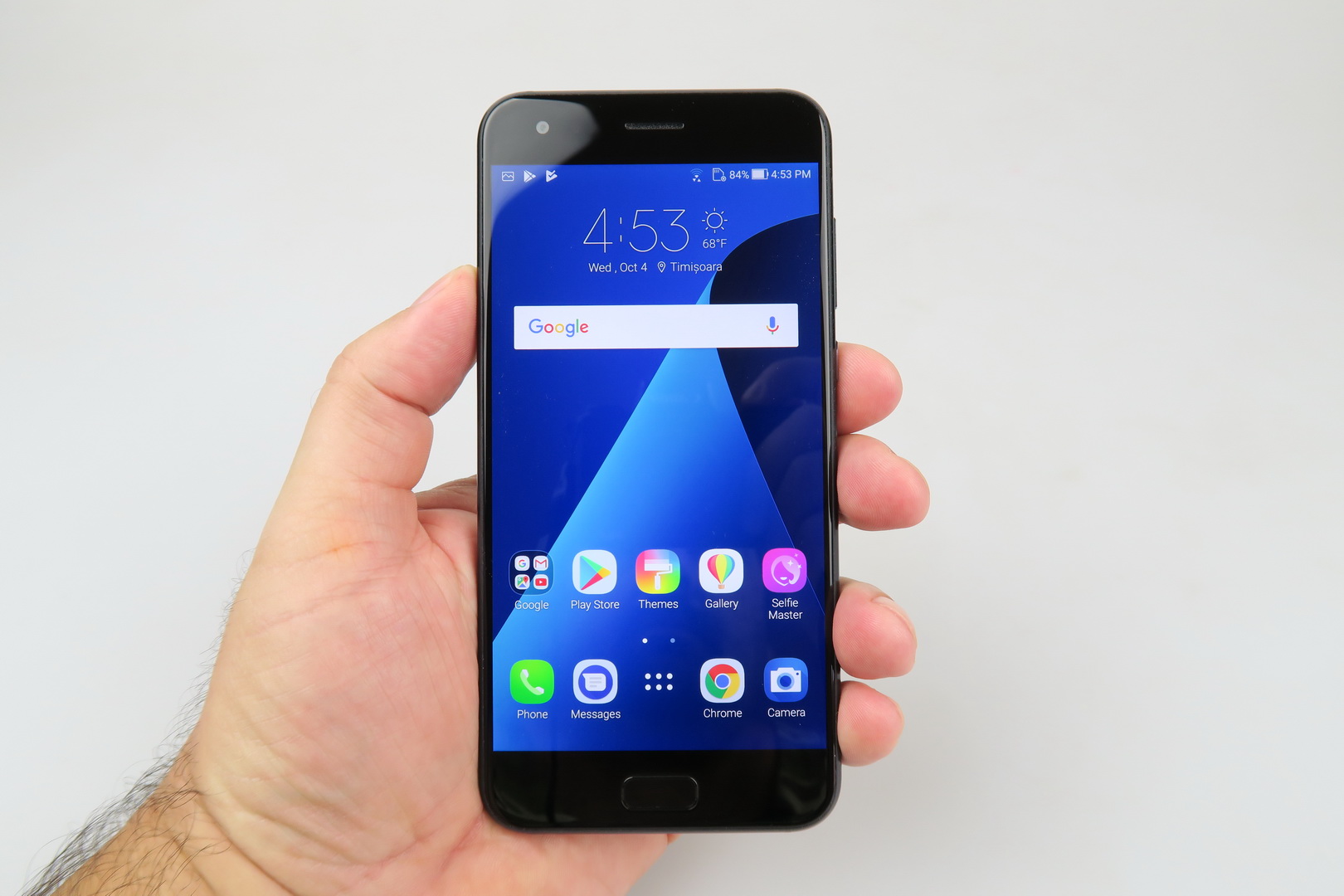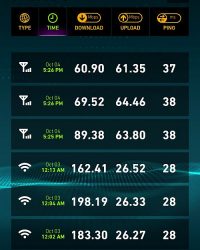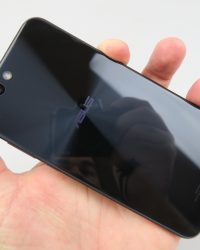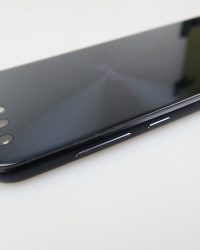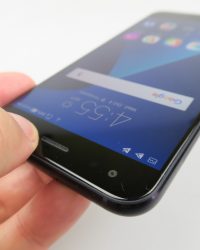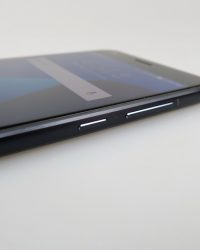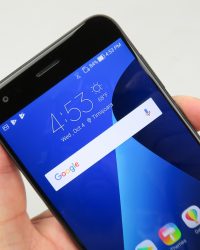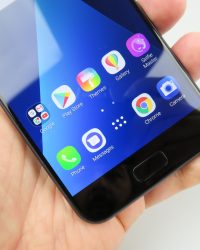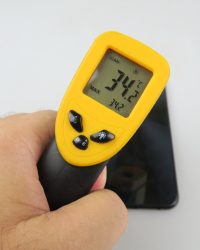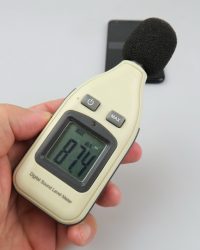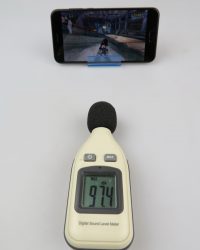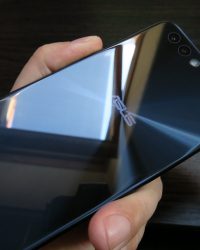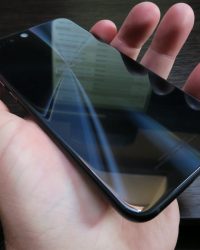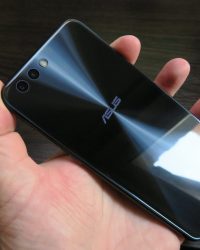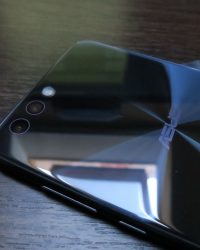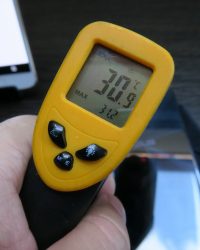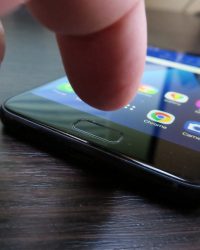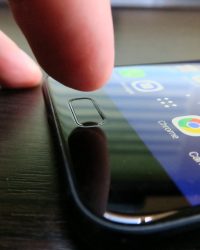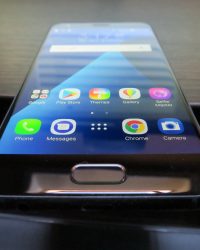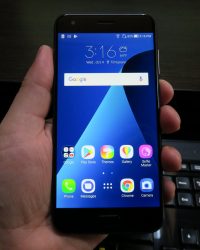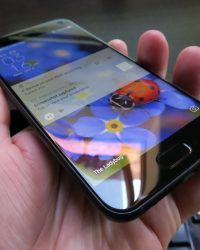The ASUS ZenFone 4 has been reviewed by us just as fall was starting, in September and now we’re back with a text review to complement the video one. This machine debuted in the EMEA space in late September and we were present in Rome to witness its launch, in the presence of ASUS CEO, Jerry Shen. We tested the ASUS ZenFone 4 ZE554KL model, basically the definer of the series. It’s a midrange machine priced at $450 and we detailed it after the break.
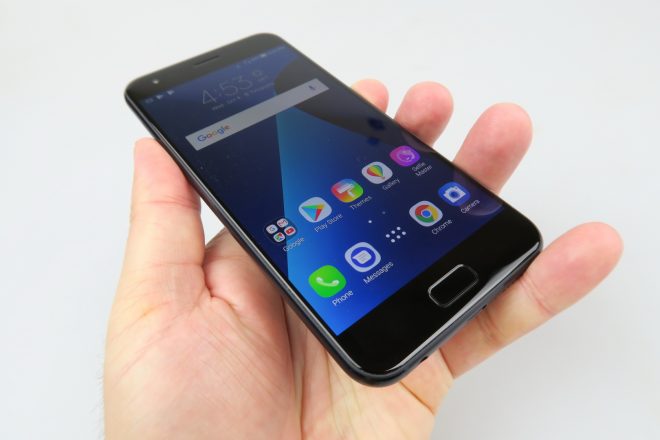
We also already unboxed the ASUS ZenFone 4 Selfie phone and we’ll be reviewing that one as soon as possible. Anyways, the ZenFone 4 ZE554KL is the focus of this review, a glass and metal device, much like its predecessor, but more stylish now. The way it’s finished emanates maturity, like the move from the enthusiastic Galaxy S6 to the mature Galaxy S7, if you remember.
This handset is a 5.5 incher, a glass and metal sandwich, with a glass panel at the back, one at the front and sandwiched between them a metal frame. We still see the nice circular pattern at the back, a sort of trademark for ASUS products, also spotted within the ZenBook lineup and other product series. The device is easily used with a single hand, has comfy buttons and it’s a bit wide.
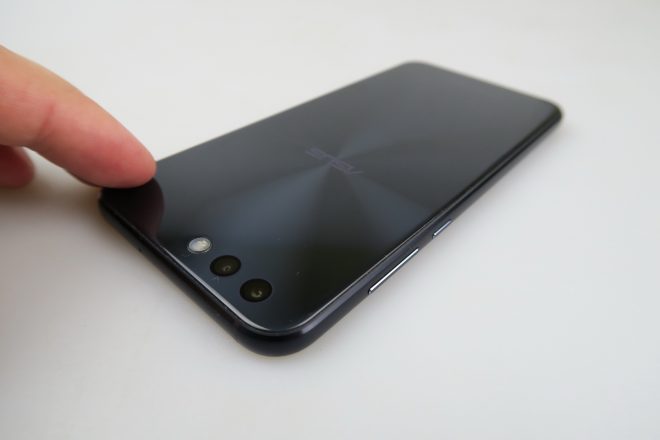
It comes with a 2.1 mm thick bezels and uses 2.5D Gorilla Glass, at both the front and back. It’s got a diamond cut metal edge, which looks very fashionable. ASUS has made this phone available in hues like black, white and a special mint green, that looks very cool. The camera at the back is very discrete, which is nice to see, compared to the bulky camera on the iPhone X for example.
ASUS ZenFone 4 measures 7.5 mm in thickness, being slimmer than the 7.7 mm ZenFone 3, but also weighs 165 grams, which is 10 grams more than the predecessor. I find it to be more refined than the ZenFone 3, more elegant and sporting a premium build and materials. The display on board is a 5.5 incher with a Super IPS+ panel and on paper it delivers 600 nits of brightness.

It’s a Full HD screen, but the bezels are not quite narrow, compared to the modern requirements. It also has an oleophobic coating applied on top of the facade. The viewing experience involved a bright and crisp image, pretty good contrast and wide view angles. Colors are well calibrated and I found the image to be a bit whiter than usual. Pixels have an RGB Stripes setup, as seen under our microscope. We used a luxmeter to measure the brightness, achieving 485 LUX units, which is quite good in the midrange area.
How good? Well, good enough to beat the Samsung Galaxy A5 (2017) and Motorola Moto Z Play. It also scores below the ASUS ZenFone 3 and its 500 LUX, but not by much. Settings include brightness level, font size and style, as well as display size. There’s also the Screen Color Mode, that lets you play with color temperature and Modes like Auto, Blue Light Filter, plus Vivid. Then there’s Custom with sliders for hue and saturation.

It’s a good display overall, so we have no complaints. Moving on to other hardware, this handset makes use of a Qualcomm Snapdragon 630 or Snapdragon 660 processor, but we have the S630 version in testing, clocked at 2 GHz. It’s an octa core 14 nm 64 bit chipset, with an Adreno 508 GPU. There are also 4 GB of RAM on board, but the S660 unit has 6 GB (LPDDR4x). Storage is at 64 GB and there’s also a microSD card slot.
We didn’t encounter any lag, during the many weeks of device usage and everything was silky smooth. We started up a ton of apps and still zero problems. Apps start up fast and there’s no stutter or delay. Games like Riptide GP Renegade run just fine and there’s also a Game Genie feature, that lets you stream the game and your face to YouTube or Twitch.
We also did benchmarks, achieving results higher than the Huawei P10 Lite and Vernee Thor in Quadrant, but lower than the Galaxy A5 (2016) and HTC One M8.

In AnTuTu 6 we went past the LG V10 and ZenFone Zoom S, which is not bad. We were surpassed by the Motorola Moto Z2 Play and Lenovo Vibe X3. In 3DMark Slingshot Extreme we scored results higher than the Galaxy A5 (2017) and Xperia XA1, which is a great result, making this a better gaming phone than those we mentioned. It also scores below the Huawei P10.
GeekBench 4 feature a surprising multi core score above the LG G6 flagship. I’d say that performance is spot on for a midranger and overall it feels like an early 2016 flagship, or at worst a 2015 one. The temperature test was fine, with 31.2 degrees Celsius reached in GFXBench and 34.2 degrees in Riptide GP Renegade, so there’s no overheating.

Moving on to the battery, we have here a 3300 mAh unit, with fast charging, which means that a 5 minute juice up will bring you 2 hours of talk time. It also means that the battery gets to 50% level in just 36 minutes of charge. On paper we are promised up to 18 hours of web browsing with a single charge. By the way, this model’s capacity is 300 mAh higher than the predecessor’s.
The video playback time we achieved on this model is 10 hours and 14 minutes, which is quite good and it beats the Sony Xperia XZ Premium, ASUS ZenFone 3 5.2 inch, but scores below the ASUS ZenFone 4 Selfie Pro and ASUS ZenFone 3 Deluxe. In PCMark things were once again solid, with 9 hours and 13 minutes, which is quite good, going past the classical 8 hour work day.
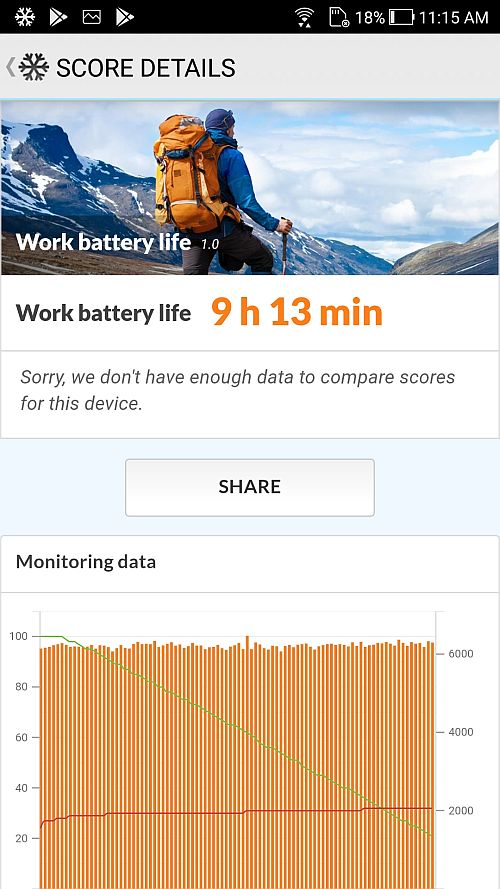
It’s also superior to the results of the Huawei Mate 8 and ASUS ZenFone 3 5.2 incher. Still, we couldn’t beat the 5.5 inch ZenFone, which beat us by 30 minutes. Huawei Nova is also superior. Charging is done in 1 hour and 55 minutes, which is pretty reasonable and faster than the Huawei Mate S and Google Pixel XL. Still, the Huawei Honor 8 charges faster.
Taking it one step at a time, we got to 6% after 5 minutes of charge, 16% after 15 minutes and 35% after 30 minutes. One hour brought us to 69%. Settings include Battery Modes like Performance, Normal, Power Saving and Super Saving, but there’s also Customization. All of them will allow you to adjust the CPU, brightness and network usage. I would say that ASUS included a solid battery this time around and while it doesn’t set any records and doesn’t raise to the level of the Galaxy A models, it’s still pretty, pretyyyy good (said with a Larry David voice).

As far as audio is concerned, we get dual speakers this time around, a combo of the bottom speaker and the earpiece, working in tandem. We also get hi res acoustics, the 24 bit kind and DTS HeadphoneX option with 7.1 surround. Dual noise cancelling microphones have also been included. Google Play Music is the music player of choice and ASUS, just like Samsung has decided to skip including its own music player this time.
Audio Wizard is offered separately, as an app with EQ tweaks and with the ZenFone 4 debuts a new UI for it. Options include Stereo, Mono, Outdoor, plus Modes like Normal, Pop. Vocal, Rock and Custom. There are 6 custom channels here and options for bass, treble and more, with channels included. The listening experience brought on a great voice and very high volume, especially with the Outdoor mode on.
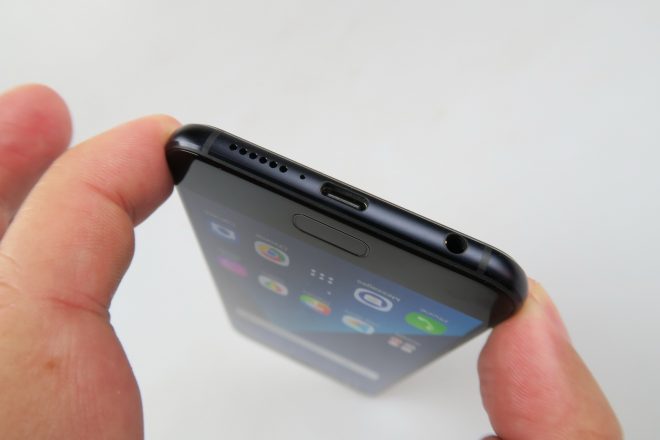
It would even it’s too loud and a bit distorted with that mode on. The back of the phone doesn’t vibrate and I’d say that the bass and highs are excellent. The headphones are very similar to the ones bundled with the ZenFone 3 last year, in both design and comfiness. They have excellent noise cancelling, nice bass and loud volume, as well as a great overall sound.
We also did a decibelmeter test and achieved 87.4 dBA at the front and back of the phone, which is superior to the LG G5 and Sony Xperia XA1 Ultra, but inferior to the Galaxy A3 (2017). We did another test, where we played the Game Riptide GP Renegade and hit 97.4 dBA in the process. This beats the Samsung Galaxy S8, Huawei P10 and LG G6, but it’s inferior to the Galaxy Note 8.

Solid all around and now finally, let’s get to the camera. The ASUS ZenFone 4 ZE554KL features a dual back camera, that includes a 12 MP and 8 MP sensor. The 12 MP one is a Sony IMX362, also used on the HTC U11 and Moto Z2 Play. It has Dual Pixel technology, F/1.8 aperture, 83 degree field of view and it measures 1/2.55 inches. It’s got 1.4 micron pixels, 4 axis OIS and PDAF.

To that we add an RGB sensor and LED flash, while the second camera, the 8 MP one has a 120 degree wide angle lens. By the way, the 4 axis OIS is for pics and there’s 3 axis electronic stabilization for video. Selfies are taken with a front 8 MP camera, with F/2.0 aperture and 84 degree lens. It also does a panoramic selfie. The camera app lets you quickly switch between cameras, like we saw on the LG G5 and G6, with a similar mechanism. Focus is very fast and precise and picture taking is also fast.

4X zoom is quite fluid and details are kept in pretty good manner. Camera options are now more limited than on the ZenFone 2 and ZenFone 3, which frankly speaking had way too many options. Now we have Portrait (Bokeh), HDR, Beaty, Super Resolution, Panorama, GIF, Time Lapse and Slow Mo. Pro lets you tweak ISO, white balance and exposure. I’m digging the new minimalistic UI by the way.
Let’s move on to the day time gallery and this is not your average walk in the pack, since we had the opportunity to take pictures during a trip in Rome with the ASUS ZenFone 4. The pictures were taken at the end of September, on a very warm weather, with zero clouds. We actually took a huge amount of shots, impressive even. Selfies are excellent, I’d say top 5 or even top 3 in 2017.

I particularly like the way the front camera catches the brown of my eyes (selfie gallery), which is not very clearly seen in other shots taken by other phones. Back to the main camera, it catches a lot of details and the monuments we photographed are very crisp. Even with the sun in front selfies kept being great, which is something that not even the Galaxy Note 8 could handle. We also have a Portrait option for selfies, which blurs the background in pretty fine manner and highlighted my face.

If you zoom into shots with the main camera you’ll experience some detail loss, but not huge. Colors look excellent and they’re calibrated perfectly, no matter the situation. Panorama has a resolution of 9600 x 864 pixels, which is not generous, but it’s reasonable. Fontana di Trevi is a tricky monument to photograph, because it’s very brightly lit, the core portion of it, but around it are tall buildings in the dark and people also in the shade.
So, there’s light and shade at the same time, but ZenFone 4 was pragmatic about it. It also caught nice lighting indoors and it’s one of the few phones that has zero problems with very bright lighting and the sun. Closeups of food were excellent, perhaps too yummy for some dieters out there. We also took wide angle shots with the secondary camera and they caught a wide field of view, ideal for a vacation by the way.

They’re pretty curved, which is something that LG fixed between the LG G5 and the G6, but ASUS has yet to work on that. I’d say that this ZenFone 4 is able to compete with the LG G6 and Huawei P10 easily, but it doesn’t raise to the level of the Galaxy Note 8 or iPhone 8 Plus, which are priced double its price by the way, but don’t have double the photo quality let’s face it.

What’s clear is that the ZenFone 3 clearly gets a photo upgrade via the ZenFone 4. As far as the low light capture is concerned, we have some visible grain going on. Zooming in resulted in clear detail loss, but in general I was happy with the texture of objects and the clarity, as well as lighting. The flash makes things appear day-like and colors are also well calibrated.
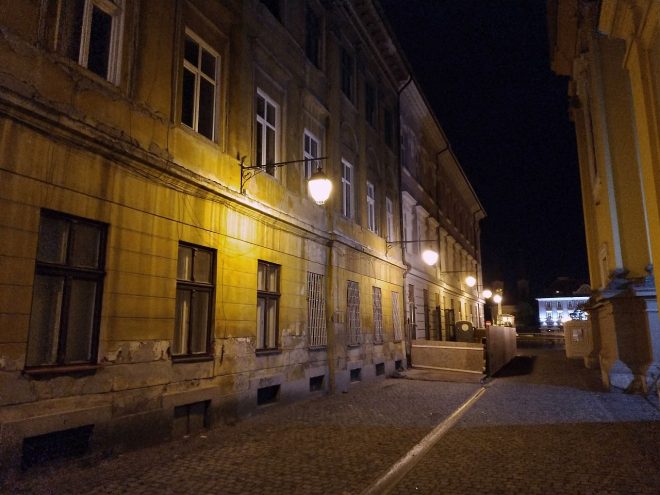
I did spot some pink hues here and there and the street light halos were quite big. I’d say the brightness and colors are good here and closeups are pretty hot, in regards to clarity and details. People who are patient enough to focus on their surroundings and calibrate options may achieve flagship-level shots. However some things are inescapable, like the visible grain and lack of details in the distance.
I’d still say that this device is superior to the ASUS ZenFone 3, but only slightly. It’s inferior to the LG G6 and maybe on par with the Huawei P10. For a midranger there are different requirements and the ZenFone 4 kind of meets them all. If you want to talk about video capture, we shot things in MP4 format, in Full HD, at 30 FPS and 20 Mbps.
There’s a bit of flicker when moving around, walking and so forth, but the microphone was great. Some refocus hit us when travelling on the streets of Rome, but clarity was always excellent, no matter what. I loved the hues of green, red and blue we caught, calibrated properly within the sRGB standard. Exposure change happened at the proper time and in discrete manner and I totally liked the dynamic range offered here (Fontana di Trevi).
Colors are solid, in both indoor and outdoor areas. The microphone was great, as revealed by that sermon in a church that we briefly caught on camera. The voices were very well heard. Everything feels great, minus the shakiness and some focus loss. This surpasses the ZenFone 3 and most Motorola phones, plus the midrange Xperias, even the LG G6, that had some flaws and the Huawei P10 Plus, which filmed with a weird green hue.
Of course it doesn’t go into HTC U11 and Galaxy S8 territory, but it holds its own. In low light conditions, I could say that the ZenFone 4 showed its weakest spot. Things are grainy as hell, halos are big, but somehow the clarity was OK. Things are dark, yellow, shaky and the mic was OK. This is Huawei P9 Lite 2016 level, but not more. Sorry guys hoping for more, this device captures some fuzzy night videos, so it’s not good for concerts or visiting a new town.
Colors, the mic and clarity are the only good things about it. And when I say clarity that’s not even guaranteed at all times. Anyway, moving on to the web browser, we’ve got Chrome here, which is rather fast, but its benchmarks aren’t impressive in results. The keyboard is comfy and it also has Swype, so another box is checked. On the connectivity front, there’s all the usual fireworks.

We’ve got dual band WiFi ac and MIMO, LTE Category 12/13, with up to 600 Mbps downloads, NFC, Bluetooth 5.0 and WiFi Direct. There’s GPS, Glonass, Galileo and a dual SIM dual standby setup which is always nice to see. Calls are loud and clear and the microphone felt perfect to be honest. We also did a SpeedTest and reached 89 Mbps in download on 4G and 64 Mbps in upload.
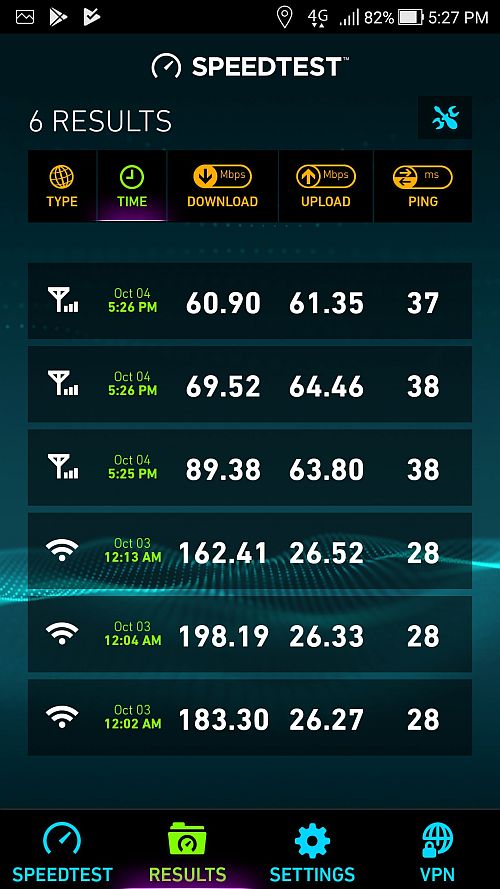
On WiFi we got to 198 Mbps in download and 26 Mbps in upload. All of those are quite OK results for an upper midranger. Time to talk software! Android 7.0 Nougat is in the mix here, with Zen UI 4.0 on top this time around. Lots of apps have been removed for the sake of the user and we like that. There are no more childish bubbles in the Quick Settings area, so more maturity now.
Multitasking happens in typical fashion, with a carousel and split screen setup. The leftmost homescreen is all about Google Now and when we keep the screen pressed there’s widgets, wallpapers and homescreen stuff, a ton of options and features to use. And I do mean A TON. There’s icon size, alignment, scroll effects, font size, icon label, colors, fonts, lock apps, preferences and more.

The dropdown bit has the notifications and quick settings, as expected, but once again with no more childish stuff. We also go into the Settings are and find the ASUS Cover option and the fingerprint scanner. There’s a 12 step setup here and the scanner is fast and accurate for unlocks. Options include SOS, Report Location, Screen Pinning, Easy Mode, Kids Mode, Twin Apps, Page Marker, Game Genie and Zen Motion.

The latter features Motion Gestures, One Hand Use and then there’s Glove Mode. Optiflex is another interesting option working as an app cleaner and cache cleaner. ASUS ZenFone 4 comes with 32 preinstalled apps, which is certainly better than the 55+ of the older ZenFones. There’s Web Storage, File Manager, Weather, Facebook and Instagram, but no more gimmicks, like Do It Later or What’s New or things like that.
Mobile Manager is also here, letting you cleanup stuff. Selfie Master is another preinstalled app, with lots of collage and tweaks for your face. With all of those being said and done, let’s see the verdict, Pros and Cons.
Here are the Pros:
- elegant design
- solid pictures and videos
- great selfies
- excellent audio
- good battery
- good performance
- bright screen
- no bloatware now
- more mature UI
And the Cons:
- pricey
- low light video could be better
- some refocusing when walking and filming
- fingerprint scanner is a bit slow
- curved wide pictures
ASUS ZenFone 4 ZE554KL is a well balanced upper midranger phone, with no major deal breaker. It’s a rival for Motorola Moto Z2 Play and Huawei Honor 9, but what’s the clearest for me is the fact that it beats the ZenFone 3. The only major drawback here is the night time picture and video capture. It can fight the LG G6 and Huawei P10, at least camera-wise, but performance is also not bad.
Other than that it’s all gold for the segment between $400 and $500. A more mature design for sure, a more mature UI signals that ASUS really means business in the smartphone segment. You can find the device here.

